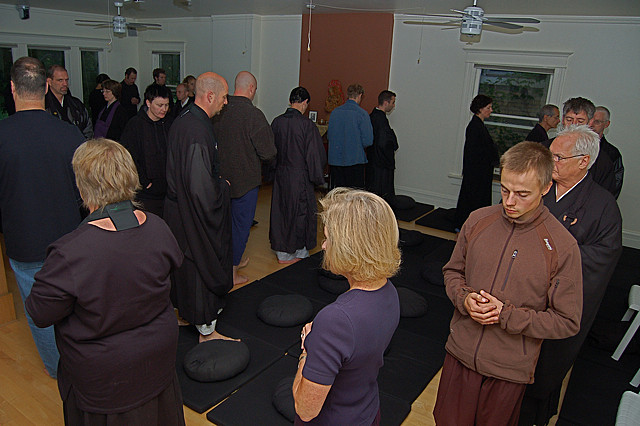In the West, the quintessential image of a meditator is someone seated with crossed legs and closed eyes. Yet, as anyone who practices yoga or tai chi can tell you, moving and meditating are not mutually exclusive.
In fact, combining meditation with movement is beneficial. And of all the ways to practice meditation in motion, walking meditation is probably the easiest. I love walking meditation because I can do it almost anywhere and anytime, and there are enough variations to keep my restless mind from getting bored.
Sharon Salzberg, co-founder of Insight Meditation Society in Barre, MA practices both mindful walking and loving-kindness while walking. We discussed walking meditation recently via Twitter.
“It’s very good when you feel sleepy or restless,” Salzberg said. “Walking raises energy and also grounds energy. It is an authentic, holistic meditation.”
Sure, it’s good. But is walking meditation as good as sitting meditation?
Although the retreat center Salzberg co-founded is renowned for its lengthy “sits,” she said there are times when walking meditation is actually more beneficial than sitting meditation.
“People sometimes replace sitting with walking if they feel the need to balance their energy,” Salzberg explained. “It is also good to practice formally so you feel confident about walking down the streets in a city like NYC at a normal pace, but with mindfulness and lovingkindness.”
Taking A Walk? Or Walking Meditation?
The difference between taking a walk and walking meditation is intention and attention. When taking a walk, you might let your mind wander, and you might listen to music or talk on the phone. Some people even read while walking (not recommended!) Typically, you intend to go somewhere.
Formal walking meditation is destinationless. Your intention is to empty the mind while walking very slowly. Salzberg describes it as a dedicated training period. You walk back and forth acknowledging thoughts as they arise and releasing them without judgement. You can do this in a room, a yard, a park, a labyrinth or on a stretch of sidewalk.
During informal walking meditation, you make the conscious choice to focus the mind, either through mantra, through mindful attention to specific aspects of the walk or through general mindfulness. You may be moving toward a destination—a favorite lunch spot, the grocery store, your workplace—and you may choose to meditate for part or all of the walk.
To do mindful walking, set the intention to connect with your higher self or with the divine (depending on your belief system), and with the beauty in all that surrounds you. Stand still for just a moment. Notice your environment and feel the energy of the earth moving through your feet, into your legs and throughout your body. As you take your first step, pay attention to the sensation of your foot falling on the ground. Continue walking at a comfortable pace. Notice the sensation of the air on your face. Is it dry or humid? Do you smell the nearby flowers, cars or other surroundings? Try to observe these things without labeling them “good” or “bad.” Notice how it feels to simply be in the experience.
The practice of non-judgemental awareness helps heighten your sense of mindfulness. Increased mindfulness is the ultimate goal of meditation—the point is not to silence yourself or the world, but to become more aware of your habitual responses to life. I believe that this awareness is what the sages were referring to when they espoused detachment.
Start walking mantra meditation the same way you start mindful walking: by setting an intention to connect with your higher self or with the divine. Choose a mantra that suits you. Perhaps you need to balance your chakras or you’d like to strengthen a particular aspect of yourself. Perhaps you need to let something go. Consider one of these:
My highest and best self pulls me forward.
I surrender to the divine.
I step forward into greatness.
I am balanced.
I am now.
With each step, repeat the mantra. If you’re alone on the path, feel the power of saying it aloud. Otherwise, you may want to repeat the mantra silently.
Lovingkindness walking can be a version of mantra walking or mindfulness walking. The intention is to send benevolent thoughts to all you meet on your walk. You may simply envision golden white light blessing everyone and everything you pass or you may repeat a loving-kindness mantra, such as “May you be blessed,” or “May all beings have peace. May all beings have joy. May all beings have love,” as you walk.
Whichever variation of walking meditation you choose, you have the opportunity to note any thoughts that arise. Now, with your heightened ability to witness without judging, you can become aware of how those habitual responses make you feel. Then let the thoughts pass like birds in the sky. They are neither good, nor bad. They are just thoughts; they have no power over you. Through the practice of walking meditation, you now see the true nature of your thoughts, and you are empowered.
Author: Rebekah Fraser
Editor: Evan Yerburgh
Image: Flickr







Read 0 comments and reply